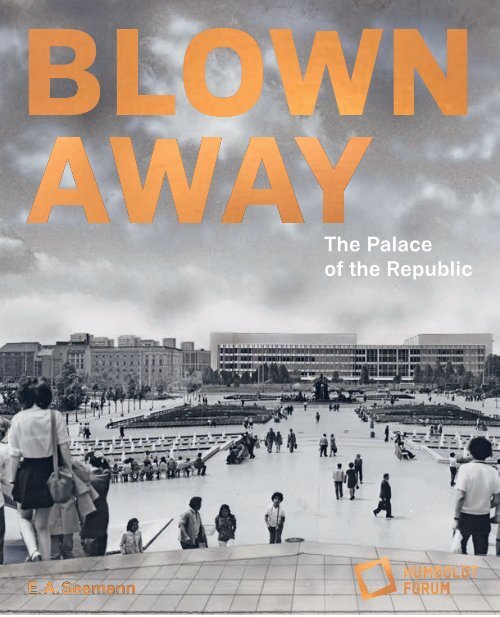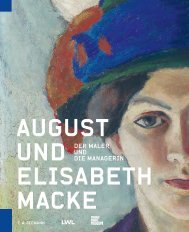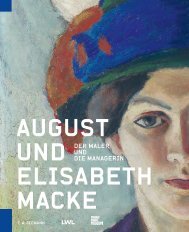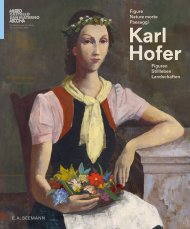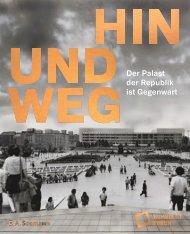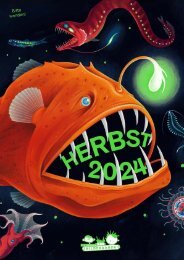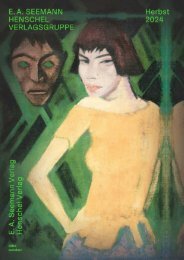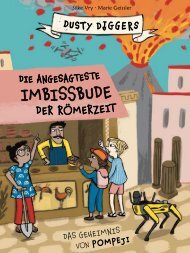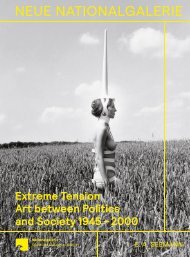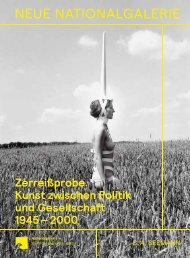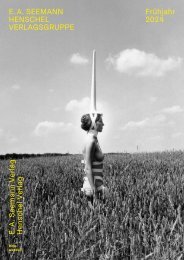Blown away - The Palace of the Republic
You also want an ePaper? Increase the reach of your titles
YUMPU automatically turns print PDFs into web optimized ePapers that Google loves.
<strong>The</strong> <strong>Palace</strong><br />
<strong>of</strong> <strong>the</strong> <strong>Republic</strong>
BLOWN<br />
AWAY<br />
<strong>The</strong> <strong>Palace</strong><br />
<strong>of</strong> <strong>the</strong> <strong>Republic</strong><br />
E. A. Seemann
CONTENTS<br />
14 BLOWN AWAY<br />
<strong>The</strong> <strong>Palace</strong> <strong>of</strong> <strong>the</strong> <strong>Republic</strong><br />
Karen Buttler, Hartmut Dorgerloh,<br />
Judith Prokasky, Anke Schnabel<br />
22 FLASHBACKS<br />
1950–1989<br />
32 1950–1989 Up and Coming<br />
Reinhard Alings<br />
48 PHOTO COLLAGES<br />
51 PALACES OF CULTURE<br />
An Attempt at Elucidation<br />
Uta Kornmeier<br />
61 NO PLACE FOR MARX<br />
AND ENGELS<br />
<strong>The</strong> Development <strong>of</strong> Marx-Engels<br />
Square from 1951 to 1989<br />
Alfred P. Hagemann<br />
69 A SOCIALIST EXPERIMENT<br />
Design in <strong>the</strong> <strong>Palace</strong><br />
<strong>of</strong> <strong>the</strong> <strong>Republic</strong><br />
Oliver Sukrow<br />
76 DESIGN OBJECTS<br />
83 THE GLASS FLOWER<br />
Form and Symbolism<br />
<strong>of</strong> an Ornament<br />
Zsófia Kelm<br />
87 PERSPECTIVES<br />
91 UTOPIA AND PARANOIA<br />
<strong>The</strong> Ministry for State Security<br />
at <strong>the</strong> <strong>Palace</strong> <strong>of</strong> <strong>the</strong> <strong>Republic</strong><br />
Dagmar Hovestädt<br />
98 MOMENTS<br />
105 TRENCH COAT, SANDWICH,<br />
AND THE SITE<br />
Memories <strong>of</strong> <strong>the</strong> <strong>Palace</strong><br />
Ilko-Sascha Kowalczuk<br />
112 THE PALACE EVENTS PROGRAMME<br />
Culture and Entertainment<br />
in <strong>the</strong> Spirit <strong>of</strong> Internationalism<br />
Constanze Fritzsch<br />
119 EVENT POSTERS<br />
127 In <strong>the</strong> <strong>Palace</strong> <strong>of</strong> <strong>the</strong> <strong>Republic</strong><br />
with Willi Sitte<br />
Aron Boks<br />
131 MEMENTOS
1989–1990<br />
136<br />
1989–1990 Tipping Point<br />
Reinhard Alings<br />
142 PERSPECTIVES<br />
1990–2013<br />
150 1990–2013 Down and Out<br />
Reinhard Alings<br />
158 PORTRAITS<br />
174 SPRAYED ASBESTOS IN THE<br />
PALACE OF THE REPUBLIC<br />
<strong>The</strong> Genesis <strong>of</strong> an Exception<br />
Bruno Torres Suñén<br />
180 OF DREAMS AND CONSTRUCTS<br />
<strong>The</strong> <strong>Palace</strong> <strong>of</strong> <strong>the</strong> <strong>Republic</strong> as a<br />
Place <strong>of</strong> Remembrance<br />
Hanno Hochmuth<br />
184 PERSPECTIVES<br />
187 MEMENTOS<br />
191 WHO OWNS THE CENTRE?<br />
Who Narrates Our Society?<br />
Gesine Danckwart<br />
196 INTERIM PALACE USE<br />
201 MY PALACE<br />
<strong>The</strong> <strong>Palace</strong> <strong>of</strong> <strong>the</strong> <strong>Republic</strong><br />
as Seen by a Berliner with Roots<br />
in Hamburg and Turkey<br />
Gülşah Stapel<br />
205 dazzling<br />
Victoria Helene Bergemann<br />
208 THE TORETSK CONSERVATORY<br />
A People’s Garden<br />
Zhenia Moliar<br />
211 REVOLUTION BETRAYED<br />
Performing between Memory<br />
and Oblivion<br />
Shuyu Chen<br />
214 SEARCHING FOR THE PALACE<br />
Sold Off, Stored Away, Gone Astray?<br />
Dominique Falentin<br />
222 glass ghost parade<br />
Uljana Wolf<br />
APPENDIX<br />
225 Notes<br />
232 <strong>The</strong> Authors<br />
234 Recent Publications: Literature<br />
for Fur<strong>the</strong>r Reflection<br />
235 Photo Credits<br />
239 Acknowledgements
12
13
FLASHBACKS<br />
Distributed throughout <strong>the</strong> Humboldt Forum – from <strong>the</strong> cellar to <strong>the</strong> top floor – 36 Flashbacks<br />
recall important functions and historical events in <strong>the</strong> Berlin <strong>Palace</strong> and <strong>the</strong> <strong>Palace</strong> <strong>of</strong> <strong>the</strong><br />
<strong>Republic</strong>. <strong>The</strong>se key items, small ensembles <strong>of</strong> objects, and audiovisual installations are not<br />
intended as complete or chronological presentations or narrations, but instead as illustrations<br />
or examples <strong>of</strong> crucial moments in <strong>the</strong> (cultural) history <strong>of</strong> <strong>the</strong> site.<br />
<strong>The</strong> 12 Flashbacks illustrating <strong>the</strong> history <strong>of</strong> <strong>the</strong> <strong>Palace</strong> <strong>of</strong> <strong>the</strong> <strong>Republic</strong> form a special highlight.<br />
Conceived as a “house <strong>of</strong> <strong>the</strong> people,” this multifunctional building opened in 1976, after<br />
only three years <strong>of</strong> construction, and featured attractive events and culinary <strong>of</strong>ferings. Memories<br />
<strong>of</strong> <strong>the</strong> palace are still vibrant – as are those <strong>of</strong> <strong>the</strong> heated debates on its preservation and <strong>of</strong><br />
<strong>the</strong> cultural installations during <strong>the</strong> interim period until its demolition, in 2006. <strong>The</strong> Flashbacks<br />
bring various functions and major events at <strong>the</strong> palace back to life. Not least <strong>of</strong> all, <strong>the</strong>y attest<br />
to <strong>the</strong> superior quality <strong>of</strong> <strong>the</strong> furnishings and o<strong>the</strong>r elements in this most prestigious building<br />
project in East Germany.<br />
Two first day covers from <strong>the</strong> opening<br />
<strong>of</strong> <strong>the</strong> <strong>Palace</strong> <strong>of</strong> <strong>the</strong> <strong>Republic</strong><br />
This case displays a changing series <strong>of</strong> personal mementos<br />
that <strong>of</strong>fer insights into <strong>the</strong> history <strong>of</strong> <strong>the</strong> site.<br />
<strong>The</strong>se first day covers were donated by Peter Hannuth,<br />
<strong>the</strong> site manager in charge <strong>of</strong> interior construction for<br />
Wing 3. Signed by <strong>the</strong> general construction director,<br />
architects, and employees involved in <strong>the</strong> interior work,<br />
<strong>the</strong>y recall an event on 22 April 1976, <strong>the</strong> eve <strong>of</strong> <strong>the</strong><br />
<strong>of</strong>ficial opening, and a farewell dinner for construction<br />
managers on 10 June 1976.<br />
Manfred Gottschall (letter and stamp design), 22 April 1976<br />
Stiftung Humboldt Forum im Berliner Schloss, donated by Peter Hannuth, 2021<br />
22
Signage system element<br />
<strong>The</strong> <strong>Palace</strong> <strong>of</strong> <strong>the</strong> <strong>Republic</strong> was planned as a public building.<br />
Its many different functions called for a complex signage system that<br />
would allow visitors to find <strong>the</strong>ir way around easily and independently.<br />
Klaus Wittkugel designed a system <strong>of</strong> pictograms for illuminated signs.<br />
<strong>The</strong>y were based on international design standards established<br />
in <strong>the</strong> 1960s to provide information and guidance at large events.<br />
Klaus Wittkugel (pictograms), Peter Rockel, VEB Ingenieurhochbau Berlin (design),<br />
VEB Leuchtenbau Leipzig (production), 1975, Stiftung Humboldt Forum im Berliner Schloss<br />
Flashbacks<br />
23
1950 – 1989<br />
32<br />
Reinhard Alings
Reinhard Alings<br />
Up and Coming<br />
On 19 September 1990, <strong>the</strong> <strong>Palace</strong> <strong>of</strong> <strong>the</strong> <strong>Republic</strong> was<br />
abruptly closed by order <strong>of</strong> East Germany’s Council <strong>of</strong><br />
Ministers because <strong>of</strong> severe asbestos contamination.<br />
Many <strong>of</strong> its employees arrived that morning to find <strong>the</strong><br />
doors locked. <strong>The</strong>y were especially hard hit by <strong>the</strong> closure,<br />
which brought welfare-flanked mass lay<strong>of</strong>fs in its<br />
wake as well as a 16-year debate on <strong>the</strong> palace’s fate that<br />
culminated in its demolition. Of its 1,800 employees<br />
in 1989, only 60 were still engaged in 1990, mainly occupied<br />
with shutting it down.<br />
When <strong>the</strong> German Democratic <strong>Republic</strong> (GDR) <strong>of</strong>ficially<br />
joined <strong>the</strong> Federal <strong>Republic</strong> <strong>of</strong> Germany (BRD), on<br />
3 October 1990, ownership <strong>of</strong> <strong>the</strong> palace was transferred<br />
to <strong>the</strong> Federal Ministry <strong>of</strong> Finance. On 29 October, <strong>the</strong><br />
BRD dissolved <strong>the</strong> palace as an institution, and on 1 November<br />
all <strong>of</strong> its technical systems were closed down except<br />
for a skeleton service. For <strong>the</strong> requisite remediation<br />
<strong>of</strong> carcinogenic sprayed asbestos, all <strong>the</strong> furnishings and<br />
most <strong>of</strong> <strong>the</strong> technical equipment had to be removed and<br />
<strong>the</strong> entire building gutted. On 8 May 1991, <strong>the</strong> Ministry<br />
<strong>of</strong> Finance commissioned VEBEG GmbH, a federally<br />
owned company, to sell or dispose <strong>of</strong> <strong>the</strong> inventory<br />
<strong>of</strong> <strong>the</strong> “former <strong>Palace</strong> <strong>of</strong> <strong>the</strong> <strong>Republic</strong>.” This launched a<br />
process that sent individual parts <strong>of</strong> <strong>the</strong> palace all over<br />
<strong>the</strong> world. 1<br />
▶ Dominique Falentin, <strong>The</strong> Search for <strong>the</strong> <strong>Palace</strong>, p. 214<br />
In <strong>the</strong> following, key aspects <strong>of</strong> <strong>the</strong> history <strong>of</strong> <strong>the</strong> <strong>Palace</strong><br />
<strong>of</strong> <strong>the</strong> <strong>Republic</strong>, from its urban development planning<br />
to its building design and subsequent use through 1989.<br />
Where relevant, reference is made to o<strong>the</strong>r articles in<br />
this volume with more detailed treatment <strong>of</strong> individual<br />
topics.<br />
THE PLANNING HISTORY<br />
On 27 March 1973, <strong>the</strong> government <strong>of</strong> <strong>the</strong> GDR made<br />
<strong>the</strong> decision to build <strong>the</strong> <strong>Palace</strong> <strong>of</strong> <strong>the</strong> <strong>Republic</strong>. This<br />
marked <strong>the</strong> end <strong>of</strong> decades <strong>of</strong> planning. <strong>The</strong> urban design<br />
considerations that went into <strong>the</strong> decision also reflect<br />
political and ideological changes and developments<br />
in <strong>the</strong> country that began in <strong>the</strong> early 1950s.<br />
<strong>The</strong> Marx-Engels Square area with viewing stand<br />
under construction, 1951<br />
<strong>The</strong> site<br />
<strong>The</strong> prominent position on Spree Island played a key<br />
role in <strong>the</strong> planning, design, and construction <strong>of</strong> what<br />
was envisaged as a so-called “Central Building.” <strong>The</strong><br />
Schlossplatz, or <strong>Palace</strong> Square, which was rechristened<br />
Marx-Engels-Platz (Marx-Engels Square) in 1951 and<br />
1950–1989<br />
33
DESIGN OBJECTS<br />
<strong>The</strong> Humboldt Forum’s collection contains roughly one thousand objects from <strong>the</strong> interior <strong>of</strong> <strong>the</strong><br />
palace and is expanding with <strong>the</strong> help <strong>of</strong> donations and purchases. Research was done to find<br />
<strong>the</strong> creators <strong>of</strong> many <strong>of</strong> <strong>the</strong>se objects, and some works – such as <strong>the</strong> ceramic wall art in <strong>the</strong> staff<br />
canteen – appear here in a publication for <strong>the</strong> first time. <strong>The</strong> collection and items on loan reflect<br />
both <strong>the</strong> tradition <strong>of</strong> innovative design in East Germany and <strong>the</strong> taste <strong>of</strong> <strong>the</strong> respective period.<br />
Ashtray, candleholder, and vase from <strong>the</strong> “Iris” porcelain series by Jutta Schulz<br />
76
C<strong>of</strong>fee sets by Gün<strong>the</strong>r Pucher and Peter Smalun,<br />
<strong>Palace</strong> <strong>of</strong> <strong>the</strong> <strong>Republic</strong> signet by Klaus Wittkugel<br />
Design Objects 1950–1989<br />
77
MOMENTS<br />
<strong>The</strong> “house <strong>of</strong> <strong>the</strong> people” was popular not only for its broad range <strong>of</strong> cultural<br />
events but also for its restaurants and bars and its general quality as<br />
a place to meet and spend time. Many people celebrated special moments<br />
in <strong>the</strong>ir lives at <strong>the</strong> palace, and for o<strong>the</strong>rs it was <strong>the</strong>ir day-to-day workplace.<br />
Disco<strong>the</strong>que at <strong>the</strong> Jugendtreff<br />
(youth club)<br />
98
Dance event at <strong>the</strong> Jugendtreff (youth club)<br />
Moments 1950–1989<br />
99
EVENT POSTERS<br />
Rock concerts, folk dances, cabaret performances, classical music – cultural<br />
events at <strong>the</strong> <strong>Palace</strong> <strong>of</strong> <strong>the</strong> <strong>Republic</strong> were many and varied, as were <strong>the</strong>ir<br />
publicity materials. Flyers, elaborate booklets, and large posters were<br />
created by a “who’s who” <strong>of</strong> East German graphic designers and illustrators.<br />
Modern Soul Band, programme flyer,<br />
design by Carla and Detlef Mann, 1982<br />
1950–1989<br />
119
Posters for a national art festival series with selected cultural ensembles from East German districts,<br />
design by Axel Dehlsen, 1978–80<br />
120 Event Posters
PORTRAITS<br />
Judith Enders<br />
Political scientist and co-founder <strong>of</strong> <strong>the</strong><br />
initiative Third-Generation East<br />
Judith Enders was 13 years old when she heard on <strong>the</strong> news that <strong>the</strong> Berlin<br />
Wall had opened up. Instinctively, she understood that <strong>the</strong> world she knew<br />
would change. <strong>The</strong> experience <strong>of</strong> turmoil and upheaval in <strong>the</strong> years that<br />
followed would continue to occupy her. She felt <strong>the</strong> closing <strong>of</strong> <strong>the</strong> <strong>Palace</strong><br />
<strong>of</strong> <strong>the</strong> <strong>Republic</strong> and its subsequent demolition revealed an overbearing and<br />
arrogant attitude towards people who had lived in East Germany.<br />
At university in Berlin, she majored in political science, in part to better understand<br />
and study <strong>the</strong> change in socio-political systems she had experienced.<br />
In 2009, she and o<strong>the</strong>r members <strong>of</strong> her generation still felt insufficiently<br />
represented in public discourse, and <strong>the</strong>y created <strong>the</strong> initiative Dritte<br />
Generation Ost (Third-Generation East).<br />
158
Many liberties<br />
What I experienced in <strong>the</strong> first two years after <strong>the</strong> Wall<br />
fell, in 1989 and 1990, was an incredible sense <strong>of</strong> newfound<br />
freedom. For one thing, <strong>the</strong> adults – teachers at<br />
school, for example – were unsettled by this change. <strong>The</strong><br />
entire school seemed to step back: it relaxed its hold as<br />
an institutional authority and gave us, <strong>the</strong> students, a lot<br />
<strong>of</strong> freedom. At <strong>the</strong> same time, as a result <strong>of</strong> <strong>the</strong> enormous<br />
social changes that were happening, our parents were<br />
withdrawing as well. <strong>The</strong>y made less <strong>of</strong> an attempt to regiment<br />
our teenage lives. Looking back now, I would say<br />
that <strong>the</strong>y were barely able to deal with us, that we had<br />
to take care <strong>of</strong> ourselves. I’m sure that experience made<br />
some people anxious or fearful. But for me it meant an<br />
increase in autonomy, a positive experience <strong>of</strong> an archy.<br />
<strong>The</strong>re was a new, chiller vibe, peaceful and hippy-like.<br />
This joy and people’s creative fervour to shape <strong>the</strong>ir new<br />
lives was something that I experienced as very positive<br />
and freeing.<br />
A gesture <strong>of</strong> dominance<br />
I still remember how <strong>the</strong>y took <strong>of</strong>f <strong>the</strong> inner part <strong>of</strong> <strong>the</strong><br />
emblem on <strong>the</strong> palace façade – <strong>the</strong> hammer and sickle –<br />
leaving only <strong>the</strong> surrounding wreath. Even at <strong>the</strong> time, I<br />
felt that was going too far. I thought, <strong>The</strong> poor building,<br />
it always tried so hard to be nice. That’s how I saw it as<br />
a child. It wanted to be something for everyone, even if<br />
perhaps it didn’t always succeed. Why are <strong>the</strong>y shutting it<br />
down, <strong>of</strong> all places? That’s our palace!<br />
For me, it was like <strong>the</strong>y were shutting down a library or a<br />
school, like a hospital was being torn down or some o<strong>the</strong>r<br />
building that provided a public service – and for no good<br />
reason. It was a gesture <strong>of</strong> dominance directed against<br />
<strong>the</strong> identity <strong>of</strong> East Germans. You could identify positively<br />
or negatively with <strong>the</strong> palace, but ei<strong>the</strong>r way you identified<br />
with it. To completely wipe it out, to raze it to <strong>the</strong> ground – I<br />
felt that was quite aggressive.<br />
Generational questions<br />
<strong>The</strong> year 2009 marked <strong>the</strong> twentieth anniversary <strong>of</strong> <strong>the</strong><br />
Wall coming down, and <strong>the</strong>re were a great number <strong>of</strong> public<br />
celebrations. In all <strong>the</strong> discussions <strong>of</strong> what <strong>the</strong> German<br />
Democratic <strong>Republic</strong> [GDR] had been like, it was striking<br />
that <strong>the</strong> people doing <strong>the</strong> talking were mostly older<br />
men from <strong>the</strong> West, along with Wolfgang Thierse as <strong>the</strong><br />
only East German. Young and female voices were absent.<br />
That’s why, in 2009, we established Third-Generation East.<br />
We began by organizing two conferences on questions <strong>of</strong><br />
identity and public positioning. We published books, hosted<br />
events, and did a lot <strong>of</strong> media work.<br />
Third-generation East Germans are those who were born<br />
between 1975 and 1985, children who, with a few rare<br />
exceptions, did not come into conflict with <strong>the</strong> powerful<br />
state authorities <strong>of</strong> <strong>the</strong> GDR. We were spared that experience;<br />
we just got lucky.<br />
Why did this process <strong>of</strong> engaging with our origins only<br />
happen in 2009? In 1989, all we wanted to do was see<br />
<strong>the</strong> world; <strong>the</strong> GDR and its history weren’t important to us<br />
at that time. We were looking to <strong>the</strong> West and travelling to<br />
<strong>the</strong> West. I think this exploration <strong>of</strong> <strong>the</strong> o<strong>the</strong>r world was<br />
necessary in order to see how we fit into it and to realise,<br />
“I’m different from people socialised in <strong>the</strong> West.”<br />
<strong>The</strong>n <strong>the</strong>re were <strong>the</strong> various ways to depreciate “East Germans,”<br />
things that we – and above all, our parents – experienced.<br />
We had to look on, as our parents and grandparents<br />
were subjected to structural discrimination and<br />
suffered as a result. You need a certain amount <strong>of</strong> time<br />
to process that when you’re young; it takes a while before<br />
you’re emotionally able and ready to deal with it.<br />
From an interview on 29 March 2023,<br />
conducted and edited by Mareen Maaß<br />
Portraits 1990–2013<br />
159
MEMENTOS<br />
Olaf Sarnow<br />
A photo <strong>of</strong> a tattoo <strong>of</strong> <strong>the</strong> Glass<br />
Flower on Instagram – Philipp<br />
Hennermann posted it on his pr<strong>of</strong>ile after tattooing it<br />
on Olaf Sarnow’s thigh. O<strong>the</strong>r tattoo artists had refused<br />
to accommodate <strong>the</strong> 53-year-old’s wishes, as it’s a<br />
chal lenge to depict transparent material in a tattoo.<br />
Hennermann studied <strong>the</strong> glass-and-steel sculpture and<br />
produced an image <strong>of</strong> it toge<strong>the</strong>r with one <strong>of</strong> <strong>the</strong> legendary<br />
s<strong>of</strong>as and planters from <strong>the</strong> foyer. It was <strong>the</strong> 17th <strong>of</strong><br />
Sarnow’s 21 tattoos.<br />
Photograph and tattoo<br />
Philipp Hennermann, 2022<br />
Privately owned<br />
Regardless <strong>of</strong> East German politics, people always had a positive relationship<br />
with <strong>the</strong> <strong>Palace</strong> <strong>of</strong> <strong>the</strong> <strong>Republic</strong>. Although as a teenager I was by no<br />
means a conformist. I’m not some kind <strong>of</strong> GDR freak pining for <strong>the</strong> old days.<br />
It’s just a part <strong>of</strong> my history. Even if I didn’t spend all my time in front <strong>of</strong> <strong>the</strong><br />
Glass Flower, somehow it’s still a part <strong>of</strong> me.<br />
From an audio interview conducted by Christian Schmidt<br />
on 9 May 2023 and edited by Anke Schnabel<br />
1990–2013<br />
187
Sven Swora<br />
An interest in architecture was something Sven Swora<br />
virtually inherited at birth. His fa<strong>the</strong>r, Karl- Ernst Swora,<br />
was responsible for a series <strong>of</strong> public buildings put up by a state-owned<br />
construction company in Berlin and, as deputy head architect from 1973, he<br />
oversaw <strong>the</strong> interior construction <strong>of</strong> <strong>the</strong> <strong>Palace</strong> <strong>of</strong> <strong>the</strong> <strong>Republic</strong>. Like o<strong>the</strong>r<br />
architects who participated in <strong>the</strong> project, he campaigned for <strong>the</strong> building’s<br />
preservation until his death, in 2001. With this painting, Sven memorializes<br />
his own loss while honouring <strong>the</strong> work <strong>of</strong> his fa<strong>the</strong>r.<br />
Der Palast der Republik von der Spreeseite<br />
(<strong>The</strong> <strong>Palace</strong> <strong>of</strong> <strong>the</strong> <strong>Republic</strong><br />
Seen from <strong>the</strong> Banks <strong>of</strong> <strong>the</strong> Spree)<br />
Sven Swora, 9 September 2002<br />
Watercolour<br />
Privately owned<br />
<strong>The</strong> palace painting was done a year after my fa<strong>the</strong>r’s<br />
death. I never intended it as a way <strong>of</strong> marking <strong>the</strong> anni <br />
versary, but that’s what it became. I believe everything<br />
always happens as it is meant to, subconsciously. I sat<br />
<strong>the</strong>re and saw how <strong>the</strong> palace façade got greyer and<br />
greyer, because <strong>the</strong> building had been abandoned. And<br />
as soon as a building is no longer in operation, it begins<br />
to decay. In this painting, I made <strong>the</strong> facade especially<br />
colourful so that it appears to glow a bit.<br />
From an audio interview conducted by Ralf Pasch<br />
on 28 April 2023 and edited by Karen Buttler<br />
Mementos 1990–2013 189
198 Interim <strong>Palace</strong> Use
Interim <strong>Palace</strong> Use 1990–2013<br />
199
NOTES<br />
Buttler, Dorgerloh, Prokasky, Schnabel<br />
BLOWN AWAY<br />
<strong>The</strong> <strong>Palace</strong> <strong>of</strong> <strong>the</strong> <strong>Republic</strong><br />
1 Heinrich Wefing, “Der Palast der Republik,” in Erinnerungsorte<br />
der DDR, ed. Martin Sabrow, (Munich, 2009), pp. 134–41.<br />
2 <strong>The</strong> panel was titled “Der Palast der Republik – Erinnerungsort<br />
und materielle Kultur.” For o<strong>the</strong>r SHF publications addressing<br />
<strong>the</strong> <strong>Palace</strong> <strong>of</strong> <strong>the</strong> <strong>Republic</strong>, see Judith Prokasky, “<strong>The</strong><br />
<strong>Palace</strong> <strong>of</strong> <strong>the</strong> <strong>Republic</strong>: A German Place <strong>of</strong> Memory,” in <strong>The</strong><br />
Humboldt Forum in <strong>the</strong> Berlin <strong>Palace</strong>, ed. Stiftung Humboldt<br />
Forum im Berliner Schloss (Munich, 2020), pp. 114–15; Humboldt<br />
Forum: History <strong>of</strong> <strong>the</strong> Site: Exhibition Guide, ed. Stiftung<br />
Humboldt Forum im Berliner Schloss (Munich, 2020); Vom<br />
Kloster zum Humboldt Forum, 700 Jahre Geschichte und Architektur:<br />
Ein Buch zum Tasten, Sehen und Hören, ed. Stiftung Humboldt<br />
Forum im Berliner Schloss (Berlin, 2020).<br />
3 Introduction to <strong>the</strong> material on <strong>the</strong> <strong>Palace</strong> <strong>of</strong> <strong>the</strong> <strong>Republic</strong> held<br />
by <strong>the</strong> Bundesarchiv Berlin, Bestandsgeschichte. 1. Verwaltung<br />
im Palast der Republik, http://www.argus.bstu.bundesarchiv.<br />
de/DC207-23070/index.htm?kid=ad2a891d-da18-4650-b299-<br />
f09bb45136e3 (accessed 9 November 2023).<br />
4 Anja Tack, “On <strong>the</strong> ‘Heap <strong>of</strong> Rubble from a Past Future’ – Tim<br />
Trantenroth’s Mural Recalls Berlin’s Palast der Republik,” in<br />
Contemporary Art at <strong>the</strong> Humboldt Forum, ed. Stiftung Humboldt<br />
Forum im Berliner Schloss (Berlin/Munich, 2022), pp. 61–65.<br />
5 We would like to thank Marianne Schwarzbach for putting us<br />
in touch with <strong>the</strong> artists and providing documents.<br />
6 https://sammlungenonline.humboldtforum.org/en.<br />
7 <strong>The</strong> quotation that appears at <strong>the</strong> beginning <strong>of</strong> this introduction<br />
was taken from an interview with Justin Jampol conducted<br />
by Susanne Johne and Judith Prokasky on 25 March 2021 as<br />
part <strong>of</strong> this process.<br />
8 For more, see Anke Schnabel and Judith Prokasky, “Design<br />
Thinking im Museum: Ein Erfahrungsbericht aus dem Humboldt<br />
Forum in Berlin,” in Besser ausstellen: Innovative Wege der<br />
Konzeption und Reflexion von Ausstellungen, ed. DASA, Arbeitswelt<br />
Ausstellung, Pr<strong>of</strong>essur für Museologie der Universität<br />
Würzburg, Institut für Museumsforschung (Bielefeld, 2024),<br />
pp. 121–27.<br />
9 Maurice Halbwachs, Das Gedächtnis und seine sozialen Bedingungen,<br />
7th edn (Berlin, 2022).<br />
10 <strong>The</strong> film team consisted <strong>of</strong> Julia Novak (direction/interviews);<br />
Andreas Deinert, Harald Mellwig, and Dennis Streckfuss<br />
(camera); and Sascha Czycykowski, Michele Gambarara, and<br />
Matthias Kreitschmann (sound).<br />
11 <strong>The</strong> interviewees included people involved in <strong>the</strong> building <strong>of</strong><br />
<strong>the</strong> palace, including Frank Arndt, Wolf R. Eisentraut, and Brigitte<br />
Fahlisch; artists such as Vera Oelschlegel, Gertraude Pohl,<br />
and Pierre Sanoussi-Bliss; members <strong>of</strong> <strong>the</strong> People’s Chamber<br />
such as Sabine Bergmann-Pohl, Jens Reich, and Wolfgang<br />
Thierse; and Amelie Deuflhard and Philipp Oswalt, <strong>the</strong> organisers<br />
<strong>of</strong> <strong>the</strong> ZwischenPalastNutzung association, which oversaw<br />
<strong>the</strong> interim use <strong>of</strong> <strong>the</strong> palace as a cultural venue.<br />
12 <strong>The</strong> overarching project “Memory Work at <strong>the</strong> Humboldt<br />
Forum” (2021–24) is located in <strong>the</strong> academy <strong>of</strong> <strong>the</strong> Stiftung<br />
Humboldt Forum, its Education, Learning and Science programme<br />
department, in cooperation with <strong>the</strong> History <strong>of</strong> <strong>the</strong><br />
Site division.<br />
13 Some <strong>of</strong> <strong>the</strong> interviewees did not want <strong>the</strong>ir interviews to be<br />
recorded or shared with <strong>the</strong> public.<br />
14 <strong>The</strong> interviewers had <strong>the</strong>ir own personal opinions, which influenced<br />
how <strong>the</strong>y conducted <strong>the</strong> interviews, and <strong>the</strong>y disclosed<br />
<strong>the</strong>se views during <strong>the</strong> interview. <strong>The</strong> interviews can<br />
be found in <strong>the</strong> collection maintained by <strong>the</strong> History <strong>of</strong> <strong>the</strong><br />
Site division.<br />
Reinhard Alings<br />
1950–1989 UP AND COMING<br />
1 In addition to specific research reports commissioned by <strong>the</strong><br />
Stiftung Humboldt Forum, this essay is largely based on <strong>the</strong><br />
following works: Martin Beerbaum et al., Der Palast der Republik<br />
(Leipzig, 1977), Thomas Beutelschmidt and Julia M. Novak<br />
(eds.), Ein Palast und seine Republik: Ort – Architektur – Programm<br />
(Berlin, 2001); Aufbauleitung Sondervorhaben Berlin (ed.),<br />
Ein Palast der Republik und seine Erbauer: 1973–1976 (Berlin, 1976);<br />
Amelie Deuflhard et al. (eds.), Volkspalast: Zwischen Aktivismus<br />
und Kunst / <strong>The</strong>ater der Zeit (n.p., 2006); Gerd Dietrich,<br />
Kulturgeschichte der DDR, 3 vols. (Bonn, 2019); Gabriele Dolff-<br />
Bonekämper and Hiltrud Kier (eds.), Städtebau und Staatsbau<br />
im 20. Jahrhundert (Munich and Berlin, 1996); Werner Durth<br />
et al., Architektur und Städtebau der DDR, 2 vols. (Frankfurt am<br />
Main and New York, 1998); Wolf R. Eisentraut, Zweifach war des<br />
Bauens Lust (Berlin, 2023); Bruno Flierl, Haus Stadt Mensch: Über<br />
Architektur und Gesellschaft: Gespräche mit Frank Schumann ( Berlin<br />
2019); Matthias Grünzig, Der Fernsehturm und sein Freiraum<br />
( Berlin, 2022); Kirsten Heidler (ed.), Von Erichs Lampenladen zur<br />
Asbestruine (Berlin, 1998); Moritz Holfelder, Der Palast der Republik:<br />
Aufstieg und Fall eines symbolischen Gebäudes (Berlin 2008);<br />
Internationale Expertenkommission Historische Mitte Berlin,<br />
Historische Mitte Berlin, vol. 1: Abschulssbericht, vol. 2: Materialien<br />
(n.p., 2002); Elmar Kossel, Hermann Henselmann und die Mo derne<br />
(Königstein in Taunus, 2013); Thorsten Klapsch, Palast der<br />
Republik (Mannheim, 2010); Anke Kuhrmann, Der Palast der Republik<br />
(Petersberg, 2006); Steffen Mau, Lütten Klein (Frankfurt<br />
am Main, 2019); Palast der Republik [issuing body], Palast der<br />
Republik (Dresden, 1977); Palast der Republik, ed. Elke Neumann,<br />
exh. cat. Kunsthalle Rostock (Halle an der Saale, 2019); Joachim<br />
Palutzki, Architektur in der DDR (Berlin, 2000); Michael Phillip,<br />
Dürfen Kommunisten träumen?: Die Galerie im Palast der Republik:<br />
Eine Dokumentation (Munich et al., 2017); Martin Sabrow (ed.),<br />
Erinnerungsorte der DDR (Munich, 2009); Alexander Schug<br />
(ed.), Palast der Republik: Politischer Diskurs und private Erinnerung<br />
(Berlin, 2007); Frieder Sieber and Hans Fritsche, Bauen in der<br />
DDR (Berlin, 2006); Christian von Steffelin, Palast der Republik<br />
(1994–2010) (Ostfildern, 2011); Stefan Wolle, Die heile Welt der<br />
Diktatur (Bonn, 1998).<br />
2 Cit. in Durth et al. 1998 (see note 1), vol. 1, Ostkreuz, p. 173;<br />
see also “Engineering: <strong>The</strong> Sixteen Principles <strong>of</strong> Urban Design,”<br />
https://handwiki.org/wiki/Engineering: <strong>The</strong>_Sixteen_<br />
Principles_<strong>of</strong>_Urban_Design (accessed 16 January 2024).<br />
3 Bruno Flierl, “Planung und Bau des Palastes,” cit. in Beutelschmidt<br />
and Novak 2001 (see note 1), p. 71.<br />
4 Cit. in Kuhrmann 2006 (see note 1), p. 58.<br />
Notes<br />
225
5 Contracts and reports differ considerably in <strong>the</strong>ir listed amounts<br />
<strong>of</strong> sprayed versus raw asbestos and evidently also mistook<br />
some for <strong>the</strong> o<strong>the</strong>r. According to its contact, <strong>the</strong> Limex company<br />
(GDR) ordered a total <strong>of</strong> 772 tons <strong>of</strong> “sprayed asbestos”<br />
in instalments from 1 April to 1 December 1974 along with<br />
machinery and equipment, and <strong>the</strong> interim contamination<br />
report <strong>of</strong> 16 September 1990 by <strong>the</strong> ATD company directed<br />
by Rainer Tepasse shows <strong>the</strong> same figure: BArch [Federal Archives],<br />
DC 207/137. Final documentation <strong>of</strong> asbestos removal<br />
by <strong>the</strong> engineering firm Dr-Ing. Steffen GmbH in September<br />
2003, however, lists 720 tons <strong>of</strong> “raw asbestos” and 4,500 to<br />
5,000 tons <strong>of</strong> “sprayed asbestos.”<br />
6 Kuhrmann 2006 (see note 1), p. 63.<br />
7 Klaus Beetz, “Die wirtschaftliche Seite,” in Beutelschmidt and<br />
Novak 2001 (see note 1), p. 155.<br />
8 Volker Büttner, “Die Veranstaltungen: Zwischen Pr<strong>of</strong>essionalismus<br />
und Provinzialismus,” in Beutelschmidt and Novak<br />
2001 (see note 1), pp. 158–73. <strong>The</strong> remainder is divided between<br />
events in <strong>the</strong> youth club, <strong>the</strong> TiP, disco, bowling, <strong>the</strong><br />
foyer, etc., resulting in a ratio <strong>of</strong> around 8% politics and 92%<br />
culture.<br />
9 Paul Kaiser, “Alltag ohne Epoche,” in Beutelschmidt and Novak<br />
2001, p. 132.<br />
10 One was installed on <strong>the</strong> ground floor <strong>of</strong> <strong>the</strong> Humboldt Forum,<br />
and <strong>the</strong> o<strong>the</strong>r was slightly reduced in size and placed in a conference<br />
room at <strong>the</strong> federal finance ministry.<br />
11 Kaiser 2001 (see note 9).<br />
12 Beetz 2001 (see note 7), pp. 148–57.<br />
13 Thomas Beutelschmidt, internal research request, 2022.<br />
14 17-BArch_MfS_HA_VIII_6846.<br />
15 Stefan Wolle, <strong>The</strong> Ideal World <strong>of</strong> Dictatorship: Daily Life and Party<br />
Rule in <strong>the</strong> GDR 1971–1989, trans. David Burnett (Berlin, 2019);<br />
for German original, see Wolle 1998 (see note 1), p. 58.<br />
Uta Kornmeier<br />
PALACES OF CULTURE<br />
1 Heinz Graffunder et al., Der Palast der Republik (Leipzig, 1977),<br />
pp. 10–15.<br />
2 Anke Kuhrmann, Der Palast der Republik: Geschichte und Bedeutung<br />
des Ost-Berliner Parlaments- und Kulturhauses (Petersberg, 2006),<br />
p. 155.<br />
3 This essay is based on a detailed study by Dr Thomas Beutelschmidt<br />
in 2022–23, commissioned by <strong>the</strong> Stiftung Humboldt<br />
Forum. With thanks to Alessandra Praun for her support.<br />
4 Christine Meyer, Kulturpaläste und Stadthallen der DDR: Anspruch<br />
und Realität einer Bauaufgabe (Hamburg, 2005), pp. 9–14; see<br />
also Thomas Ruben and Bernd Wagner, Kulturhäuser in Brandenburg:<br />
Bestandsaufnahme und Problemanalyse (Potsdam, 1994),<br />
pp. 15–66, esp. p. 21.<br />
5 Dieter Bartetzko and Karin Berkemann (eds.), “Kulturhäuser:<br />
Demokratie feiern,” moderneRegional, no. 3 (Summer 2023).<br />
6 Vladimir I. Lenin, Werke, vol. 36 [Russian], p. 535, cit. in Heinz<br />
Marohn, Klubs und Kulturhäuser: Platz und Funktion, Leitung und<br />
Planung, Arbeit und Wirkung (Berlin, 1978), p. 10.<br />
7 “Unsere Chronik,” Stiftung Kultur Palast, https://www.<br />
kph-hamburg.de/ueber-uns/chronik/ and Kulturpalast Wedding<br />
International, https://kulturpalastwedding.wordpress.<br />
com/ (accessed 11 December 2023).<br />
8 Cf. Anke H<strong>of</strong>fsten, Das Volkshaus der Arbeiterbewegung in Deutschland:<br />
Gemeinschaftsbauten zwischen Alltag und Utopie (Vienna et<br />
al., 2017). For <strong>the</strong> following see also Horst Groschopp, “Kulturhäuser<br />
in der DDR: Vorläufer, Konzepte, Gebrauch: Versuch<br />
einer historischen Rekonstruktion,” in Ruben and Wagner 1994<br />
(see note 4), pp. 97–178.<br />
9 See esp. Christiane Post, Arbeiterklubs als neue Bauaufgabe der sowjetischen<br />
Avantgarde (Berlin 2004), pp. 22–48; Gabriele Gorzka,<br />
Arbeiterkultur in der Sowjetunion: Industriearbeiter klubs 1917–1929:<br />
Ein Beitrag zur sowjetischen Kulturgeschichte (Berlin, 1990).<br />
10 Post 2004 (see note 9), esp. pp. 26–29.<br />
11 Lewis H. Siegelbaum, “<strong>The</strong> Shaping <strong>of</strong> Soviet Workers’ Leisure:<br />
Workers’ Clubs and <strong>Palace</strong>s <strong>of</strong> Culture in <strong>the</strong> 1930s,” International<br />
Labor and Working-Class History, 56 (October 1999),<br />
pp. 78–92, here p. 79.<br />
12 El Lissitzky, “<strong>The</strong> Club as a Social Force,” in Russia: An Architecture<br />
for World Revolution, ed. El Lissitzky, trans. Eric<br />
Dluhosch (Cambridge, MA, 1970), pp. 43–45, here pp. 43–44.<br />
13 Ibid., p. 44.<br />
14 Anna Bokov, “Soviet Workers’ Clubs: Lessons from <strong>the</strong> Social<br />
Condensers,” <strong>The</strong> Journal <strong>of</strong> Architecture, 22, no. 3 (2017),<br />
pp. 403–36, here pp. 407–11; Siegelbaum 1999 (see note 11)<br />
pp. 84–87.<br />
15 Michał Murawski and Jane Rendell, “Preface: <strong>The</strong> social condenser:<br />
a century <strong>of</strong> revolution through architecture, 1917–<br />
2017,” <strong>The</strong> Journal <strong>of</strong> Architecture, 22, no. 3 (2017), pp. 369–71.<br />
On designs and buildings <strong>of</strong> <strong>the</strong> 1920s, see Post 2004 (see<br />
note 9), p. 34; as well as Anna Bokov, Lessons from <strong>the</strong> Social<br />
Condensers: 101 Workers’ Clubs and Spaces for Mass Assembly<br />
(Zurich, 2023).<br />
16 Post 2004 (see note 9).<br />
17 Bokov 2017 (see note 14), here pp. 411–14.<br />
18 Cit. in Siegelbaum 1999 (see note 11), pp. 81–82; see also Werner<br />
Durth, “Auf der Suche nach der neuen Stadt – Parallelbau und<br />
Kontraste im deutschen Städtebau,” in Städtebau und Staatsbau<br />
im 20. Jahrhundert, ed. Gabi Dolff-Bonekämper and Hiltrud<br />
Klier (Munich and Berlin, 1996), pp. 17–38, esp. pp. 29–30.<br />
19 Ulrich Hartung, “Traditionalismus: Geschichtsbezüge und<br />
Funktionshierarchien in der frühen DDR-Architektur,” in<br />
Grammatik sozialistischer Architekturen: Lesarten historischer<br />
Städte bau forschung zur DDR, ed. Holger Barth (Berlin, 2001),<br />
pp. 127–47.<br />
20 Otto Karl Werckmeister, “Der Sowjetpalast in Moskau und<br />
die große Kuppelhalle in Berlin als projektierte Bauten einer<br />
totalitären Volksrepräsentation,” in Dolff-Bohnekämper and<br />
Klier 1996 (see note 18), pp. 113–30, citation p. 119.<br />
21 See <strong>the</strong> competition guidelines in Naum Gabo und der Wettbewerb<br />
zum Palast der Sowjets Moskau 1931–1933, ed. Beate Moser, exh.<br />
cat. Berlinische Galerie (Berlin, 1992), pp. 202–09; Karl Schlögel,<br />
“Der Schatten des imaginären Turms,” ibid., pp. 177–84.<br />
22 On Boris M. I<strong>of</strong>an, see <strong>the</strong> recent work by Wladimir Sedow,<br />
Stalins Architekt: Aufstieg und Fall von Boris I<strong>of</strong>an (Berlin, 2022).<br />
23 Michał Murawski, <strong>The</strong> <strong>Palace</strong> Complex: A Stalinist Skyscraper, Capitalist<br />
Warsaw, and a City Transfixed (Bloomington, 2019).<br />
24 Ministerialblatt der Deutschen Demokratischen Republik, 25, no. 16<br />
(September 1950), pp. 153–54; cit. in “Die 16 Grundsätze des<br />
Städtebaus,” 3 April 2005, Bundeszentrale für politische Bildung,<br />
https://www.bpb.de/<strong>the</strong>men/nachkriegszeit/wieder<br />
aufbau-der-staedte/64346/die-16-grundsaetze-des-staedte<br />
baus/ (accessed 11 December 2023).<br />
226 Notes
FAMED AND DEFAMED,<br />
REMOVED AND REMEMBERED<br />
<strong>The</strong> <strong>Palace</strong> <strong>of</strong> <strong>the</strong> <strong>Republic</strong> was <strong>the</strong> building that most<br />
exemplified political power in East Germany. Built from<br />
1973 to 1976 in <strong>the</strong> middle <strong>of</strong> Berlin, <strong>the</strong> state and cul tural<br />
centre was <strong>the</strong> seat <strong>of</strong> <strong>the</strong> Volkskammer (parliament) as<br />
well as a meeting place with event and gallery spaces,<br />
restaurants, a <strong>the</strong>atre, disco<strong>the</strong>que, and bowling alley.<br />
<strong>The</strong> first freely elected Volkskammer convened <strong>the</strong>re<br />
in March <strong>of</strong> 1990. Shortly <strong>the</strong>reafter, <strong>the</strong> building was<br />
closed because <strong>of</strong> asbestos contamination. In <strong>the</strong> early<br />
2000s, <strong>the</strong> shell was successfully used for cultural purposes<br />
but none<strong>the</strong>less demolished not much later. Today,<br />
<strong>the</strong> Humboldt Forum stands in its place. Yet <strong>the</strong> palace<br />
remains present in many people’s memories.<br />
This volume explores aspects such as closeout sales,<br />
construction site, ghosts, Glass Flower, Global South,<br />
identity, interim use, lighting system, Marx & Engels,<br />
palaces <strong>of</strong> culture, reconstruction, Stasi, and more.<br />
Recent research, artistic contributions, and personal<br />
interviews open new perspectives. <strong>The</strong> <strong>Palace</strong> <strong>of</strong> <strong>the</strong><br />
<strong>Republic</strong> <strong>the</strong>reby emerges as an all-German topic.


